You can Download KSEEB Solutions for Class 8 Maths Chapter 11 Mensuration Ex 11.1 Questions and Answers helps you to revise the complete syllabus.
KSEEB Solutions for Class 8 Maths Chapter 11 Mensuration Ex 11.1
Question 1.
A square and a rectangular field with measurements as given in the figure have the same perimeter. Which field has a larger area?
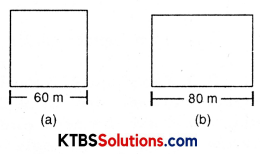
Solution:
side of square = 60 m
length of rectangle = 80 cm
Perimeter of square = 4 × side
= 4 × 60
= 240 m
Perimeter of rectangle = 2 (l + b) = 2(80 + b)
Perimeter of rectangle = perimeter of square
⇒ 2(l + b) = 4 × side
⇒ 2(80 + b) = 4 × 60
⇒ 80 + b = \(\frac{4 \times 60}{2}\)
⇒ 80 + b = 120
⇒ b = 120 – 80
⇒ b = 40 m
Area of square = (side)2
= (60)2
= 60 × 60
= 3600 m2
Area of rectangle = l × b
= 80 × 40
= 3200 m2
The area of the square is larger than the area of a rectangle.
![]()
Question 2.
Mrs. Kaushik has a square plot with the measurement as shown in the figure. She wants to construct a house in the middle of the plot. A garden is developed around the house. Find the total cost of developing a garden around the house at the rate of 25 m Rs. 55 per m2.
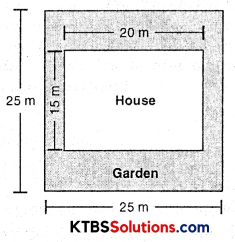
Solution:
Length of house = 20 m
Breadth of house = 15 m
Length of garden = 25 m
Breadth of garden = 25 m
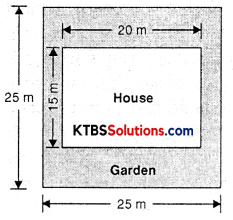
Area of garden = Area of plot – area of house
= 25 × 25 – 20 × 15
= 625 – 300
= 325 m2
Cost of developing the garden = 325 × 55 = Rs. 17875
![]()
Question 3.
The shape of a garden is rectangular in the middle and semicircular at the ends as shown in the diagram. Find the area and the perimeter of this garden [Length of rectangle is 20 – (3.5 + 3.5) meters].
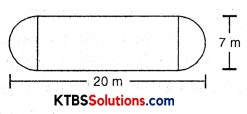
Solution:
Length of rectangle = 20 – (3.5 + 3.5)
= 20 – 7
= 13 m
Breadth of rectangle = 7 m
Radius of semi circle = \(\frac{7}{2}\) m

Perimeter of garden = 2 circle inference of semi circle + 2 (length of rectangle)
= \(\frac{2 \times 2 \pi r}{2}\) + 2l
= 2πr + 2l
= \(2 \times \frac{22}{7} \times \frac{7}{2}+2 \times 13\)
= 22 + 26
= 48 m
Area of garden = 2(Area of semicircle) + Area of rectangle
= \(2 \times \frac{\pi r^{2}}{2}+l \times b\)
= πr2 + lb
= \(\frac{22}{7} \times \frac{7}{2} \times \frac{7}{2}+13 \times 7\)
= \(\frac{77}{2}\) + 91
= \(\frac{77+182}{2}\)
= \(\frac{259}{2}\)
= 129.5 m2
![]()
Question 4.
A flooring tile has the shape of a parallelogram whose base is 24 cm and the corresponding height is 10 cm. How many such tiles are required to cover a floor of area 1080 m2? (If required you can split the tiles in whatever way you want to fill up the corners).
Solution:
Base of tile = 24 cm
Height of tile = 10 cm
Area of tile = 24 × 10 = 240 cm2
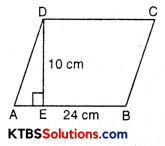
Area of floor = 1080 m2 = 1080 × 100 × 100 cm2
Number of tiles = \(\frac{\text { Area of floor }}{\text { Area of tile }}\)
= \(\frac{1080 \times 100 \times 100}{240}\)
= 45000
Question 5.
An ant is moving around a few food pieces of different shapes scattered on the floor. For which food piece would the ant have to take a longer round? Remember, the circumference of a circle can be obtained by using the expression c = 2πr, where r is the radius of the circle.
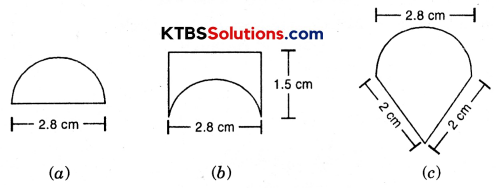
Solution:
(a) Circumference of semicircle = \(\frac{2 \pi r}{2}\) = πr
= \(\frac{22}{7} \times 1.4\)
= 22 × 0.2
= 4.4 cm
Perimeter of semicircle = πr + 2r
= 4.4 + 2 × 1.4
= 4.4 + 2.8
= 7.2 cm
![]()
(b) Perimeter of figure = Perimeter of semicirlce + Perimeter of rectangle
= \(\frac{2 \pi r}{2}\) + (2 × b + l)
= πr + 2l + b
= \(\frac{22}{7}\) × 1.4 + 2 × 1.5 + 2.8
= 22 × 0.2 + 3 + 2.8
= 4.4 + 3 + 2.8
= 10.2 cm
(c) Perimeter of figure = Perimeter of semi-circle + 2l
= \(\frac{2 \pi r}{2}\) + 2l
= πr + 2l
= \(\frac{22}{7}\) × 1.4 + 2 × 2
= 4.4 + 4
= 8.4 cm
Hence, for (b) food piece, and would have to take a longer round.